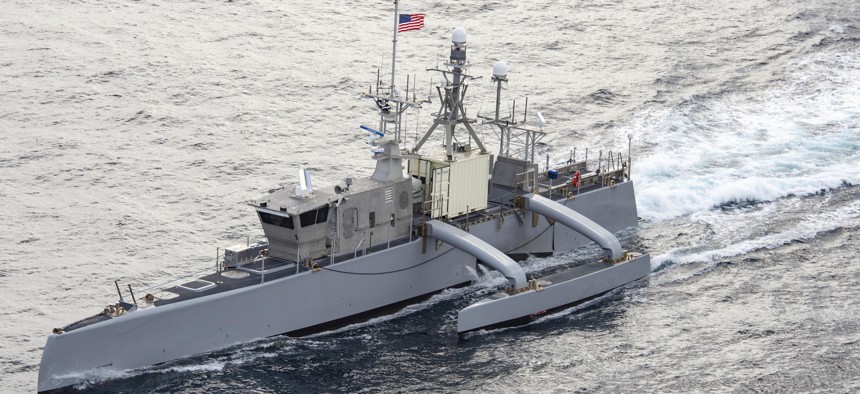
The medium displacement unmanned vessel Sea Hunter transits the Pacific Ocean to participate in Exercise Rim of the Pacific (RIMPAC) 2022. U.S. Navy / Petty Officer 1st Class Tyler Fraser
US Navy Fleet Plan Needs 3-5% Annual Budget Increases for the Next Two Decades
CNO’s Navigation Plan 2022 codifies fleet plans years in the making, but can it survive Congress?
The U.S. Navy’s planned fleet of 2045 will require annual real budget increases of 3 to 5 percent, according to the Navy’s top officer, who called that a “realistic” schedule for amassing the 500 hyperconnected manned and unmanned vessels that national security will require.
“I think it's going to take a couple of decades to get us to yield that hybrid fleet that we think that we ultimately need in order to fight the way we think we want to fight, which is in a distributed manner,” Adm. Mike Gilday, chief of naval operations, told reporters on Tuesday.
That budget growth goal “would be unprecedented if they were to be achieved by the Navy,” based on historical statistics, said Travis Sharp, fellow and director of defense budget studies at the Center for Strategic and Budgetary Assessments based in Washington, D.C.
Gilday laid out his vision in Navigation Plan 2022, a 24-page document that builds on last year’s version by adding a fleet plan called “Force Design 2045.” The plan calls for “capacity goals” of 12 aircraft carriers, 96 large and 56 small surface ships, 31 big-deck amphibs and 18 Light Amphibious Warships, about 150 unmanned surface and undersea vessels, and more. It also calls for about 1,300 carrier-based aircraft and some 900 anti-sub and anti-ship aircraft.
The CNO, who previewed these numbers in February, said they were line with the 30-year shipbuilding plan, recent Force Structure Assessments, and a recent amphibious ship study.
The document is blunt about the funding required to build this fleet—and what the Navy would choose to do if the money is unavailable.
“To simultaneously modernize and grow the capacity of our fleet, the Navy will require 3-5 percent sustained budget growth above actual inflation. Short of that, we will prioritize modernization over preserving force structure,” it says.
Even if full funding is granted, the plan depends on “retiring legacy platforms that cannot stay relevant in contested seas” and reinvesting the money in other “capabilities,” a reference to nine littoral combat ships and other vessels that Navy officials have sought to retire.
Historically speaking, the odds are against the Navy getting that kind of money.
“Over the last 75 years, only one-third of the time has the Department of the Navy's budget grown by 3 percent or more in real terms,” said CSBA’s Sharp. “If you think about those outcomes as being…the odds, it’s like one-third of the time the Navy has gotten that level of resourcing, and two-thirds of the time it has not gotten that level resourcing.”
Since World War II, Sharp said, the longest span of three-percent-or-more growth in the Navy Department’s budget is three years, and that’s only happened twice, during general military buildups: in the early 1980s, across the Carter and Reagan administrations and the early 2000s after 9/11 and amid the buildup to the Iraq war.
Various defense and congressional officials have recommended 3 to 5 percent budget growth since 2018, when both the National Defense Strategy and U.S. Institute of Peace’s 2018 report by the National Defense Strategy Commission called for it, Sharp said.
Sharp says he empathizes with the Navy, whose plans to retire older ships to fund newer ones have been partially thwarted by Congress.
“So that means that the Navy faces the budgetary pressure of having to maintain forces that it would, all things being equal, prefer not to have, while also trying to modernize the force to meet goals that it's also being given by the civilian leadership,” he said.
While the efforts in the plan are underway in this decade, its 2045 goal is farther out than the window of concern raised last year by the then-commander of U.S. Indo-Pacific Command. Adm. Phil Davidson told the Senate that China could try to take Taiwan within the decade.
If they need the fleet sooner to confront China, Gilday said they will have to “field the most ready, capable, and lethal fleet that you can. And that's exactly why our priorities have been readiness, modernization, and capacity in that order. You can't have a fleet larger than one you can sustain.”
China and Russia are again named as competitors, in line with the national defense strategy. Concerns in the plan involving China’s efforts to modernize its military and weapons systems overshadowed the brief mention of Russia’s status as an “acute threat” and its invasion of Ukraine. China’s navy and its developments informed the update, Gilday said.
“These investments in offensive warfighting systems—across all domains—are aimed at the heart of America’s maritime power,” the document states. “China designs its force for one purpose: to reshape the security environment to its advantage by denying the United States military access to the western Pacific and beyond.”
Six “Force Design Imperatives” are listed in the plan for what “capabilities” they will need for this future force, such as long-range precision fires under “expand distance” to electronic warfare and logistics under “leverage deception” and “ensure delivery,” respectively. The other imperatives are: harden defense; increase distribution; and generate decision advantage.
The document also goes over a Navigation Plan Implementation Framework for its four priorities that has been developed over the past year. The 18 objectives in the framework are each assigned to a “supported commander” to oversee, such as the chief of naval research for artificial intelligence and the deputy chief of naval operations for warfighting requirements and capabilities for unmanned systems.




